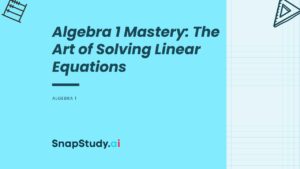Introduction
Sequences and series are fundamental concepts in algebra and form the basis of many areas in mathematics. They are crucial in understanding patterns, making predictions, and calculating sums. This article aims to dive deeper into these concepts, providing comprehensive information and examples about sequences and series.
Part 1: Understanding Sequences
What is a Sequence?
A sequence is a set of numbers arranged in a specific order. The numbers in a sequence are often called terms, and the position of each term in the sequence is its index. Sequences are everywhere in mathematics and in real life, from the sequence of numbers in a number line to the sequence of steps in a recipe.
Types of Sequences
There are many types of sequences, but one of the most common is the arithmetic sequence. An arithmetic sequence is one in which the difference between successive terms is constant. For example, the sequence 2, 4, 6, 8 is an arithmetic sequence with a common difference of 2. Other types of sequences include geometric sequences, where each term is a constant multiple of the previous term, and Fibonacci sequences, where each term is the sum of the two preceding ones.
Arithmetic Sequences
An arithmetic sequence can be defined by the formula a_n = a_1 + (n-1)d, where a_n is the nth term, a_1 is the first term, n is the term number, and d is the common difference. This formula allows us to find any term in an arithmetic sequence if we know the first term and the common difference.
Part 2: Understanding Series
What is a Series?
A series is the sum of a sequence of numbers. It is a way of adding up all the terms in a sequence. Like sequences, series are everywhere in mathematics and in daily life. For example, if you save $1 on the first day, $2 on the second day, $3 on the third day, and so on, the total amount of money you save is a series.
Types of Series
Just like sequences, there are many types of series. The sum of an arithmetic sequence, or an arithmetic series, can be found using the formula S_n = n/2(a_1 + a_n), where S_n is the sum of the first n terms, a_1 is the first term, a_n is the nth term, and n is the number of terms.
Arithmetic Series
An arithmetic series is the sum of an arithmetic sequence. For example, the sum of the arithmetic sequence 2, 4, 6, 8 would be 2 + 4 + 6 + 8 = 20. This is an arithmetic series because it is the sum of an arithmetic sequence.
Part 3: Diving Deeper
The study of sequences and series goes beyond just understanding what they are and how to calculate them. It’s about recognizing patterns, predicting future terms, and understanding the underlying principles. The ability to understand and manipulate sequences and series is a powerful tool in mathematics and is essential for advanced studies in calculus, linear algebra, and other fields.
Conclusion
Sequences and series play a critical role in many areas of mathematics and real-world applications. Whether it’s calculating the sum of a series to predict future events or understanding the pattern of a sequence to solve complex problems, having a strong grasp of these concepts is vital in the study of algebra and beyond. By taking the time to understand sequences and series deeply, you are laying a solid foundation for your future studies in mathematics.





